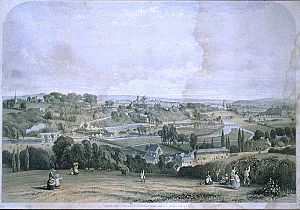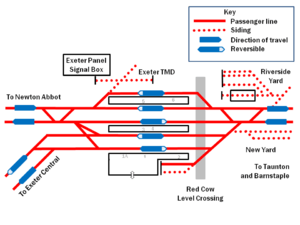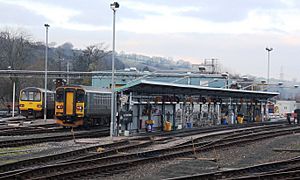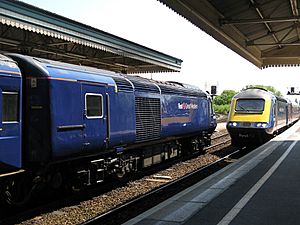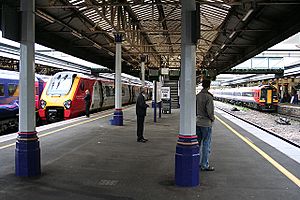Exeter St David's railway station facts for kids
Quick facts for kids
|
|
|---|---|
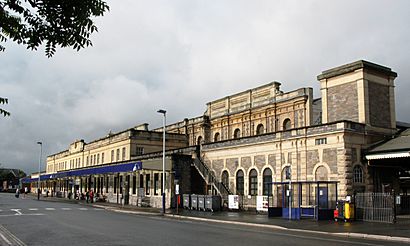 |
|
| Location | Exeter, Exeter England |
| Coordinates | 50°43′47″N 3°32′37″W / 50.7296°N 3.5435°W |
| Platforms | 6 |
| Other information | |
| Station code | EXD |
| Classification | DfT category C1 |
| History | |
| Original company | Bristol and Exeter Railway |
| Pre-grouping | Great Western Railway |
| Post-grouping | Great Western Railway |
| Key dates | |
| 1844 | Opened |
| 1864 | Rebuilt for LSWR |
| 1913 | Rebuilt without roof |
Exeter St Davids is the main railway station in Exeter, a city in Devon, England. It's about 193 miles (310 km) from London Paddington. Trains from here go to places like Plymouth and Penzance. You can also catch trains to London Waterloo via Salisbury, or local trains to Exmouth and Barnstaple.
The station first opened in 1844. It was built by the Bristol and Exeter Railway. Today, Great Western Railway manages the station. You can find trains here from Great Western Railway, South Western Railway, and CrossCountry.
Contents
History of Exeter St Davids Station
Exeter St Davids station opened on May 1, 1844. It was designed by the famous engineer Isambard Kingdom Brunel. His design was a "single-sided station." This meant both platforms were on the east side of the tracks. This was handy for passengers going into Exeter. But it also meant trains sometimes had to cross each other's paths.
At first, this wasn't a big problem. The station was at the end of the line. But on May 30, 1846, the South Devon Railway opened a new line. This line went west towards Plymouth. A shed was built for their carriages. Both companies also had sheds for goods and locomotives. These were located west of the station, near the River Exe.
Different Train Tracks and Companies
The next railway to arrive was the Exeter and Crediton Railway. It opened on May 12, 1851. This line joined the main one north of the station. All these early railways used a wide track size called the 7 ft (2,134 mm) broad gauge.
Then, on February 1, 1862, the London and South Western Railway (LSWR) arrived. They built a line from their own station, Exeter Central. The LSWR used a narrower track size, the 4 ft 8 1⁄2 in (1,435 mm) gauge. This meant the station now had two different track sizes.
With two different track sizes and four railway companies, the station needed a big update. In 1864, a new platform was built on the west side of the tracks. The old platform on the north end was closed. The station used to have separate roofs over each track. These were replaced with one large roof covering all the main tracks and platforms. A new goods shed was also built north of the station. This shed was special. It was used to move goods between trains that used different track sizes.
Changes Over Time
On January 1, 1876, the Bristol and Exeter Railway joined the Great Western Railway. A month later, the South Devon Railway also joined. The main line from Bristol was then updated. It got "mixed gauge" tracks. This meant both broad gauge and standard gauge trains could use it. This allowed trains from London Paddington to go all the way to Penzance.
The large station roof was taken down between 1912 and 1913. The platforms were made longer, stretching north. A second island platform was added on the west side. This meant the goods shed had to be made narrower. The middle island platform was mostly used for LSWR trains. The station has mostly looked the same since then.
In 1985, the signaling system was updated. This changed where some trains stopped. A new signal box was built where an old engine house used to be. Many parts of the older stations can still be seen today. For example, the main front of the station is from 1864. The Great Western Hotel is also very old.
What Exeter St Davids Looks Like
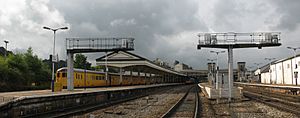
The main entrance to the station is on the east side. It faces the city centre, which is about a 15-minute walk away. Signs clearly show the way to the city and Exeter University. You can also catch buses to the city centre right outside the station. Trains to Exmouth and London Waterloo also stop at Exeter Central railway station.
Inside the station, you'll find a buffet and a bookshop. These are outside the ticket gates. There are also shops, the Great Western Hotel, and a Premier Inn nearby. A smaller buffet is available on platforms 5 and 6.
Platforms and Train Lines
The main entrance leads to platform 1. This platform is mostly used for trains going to and from Exeter Central and Barnstaple. It's long enough for two trains at once. The south end is called platform 1A. At the north end is platform 2. This is a separate platform sometimes used for trains to or from the north, like Bristol and Barnstaple.
The main bridge for passengers has cool paintings. They show old-fashioned train travel. There's also a second bridge with lifts for easy access. If the lifts aren't working, staff can help people cross the tracks safely.
The middle platforms are numbers 3 and 4. Platform 3 is used for trains similar to platform 1. Platforms 4, 5, and 6 don't connect to the lines from Exeter Central. Platform 4 is mainly for long-distance trains to Paignton, Plymouth, and Penzance. Trains from Exmouth that continue west will often stop and change direction here.
For trains heading north, like to London Paddington, you'll use platform 5. Platform 6 is used by local services and trains from Paddington that end their journey in Exeter.
Beyond platform 6 is the Exeter signal box. This controls trains not just at St Davids but also on the main line north to Taunton and south to Totnes. It also controls the lines to Exmouth and Crediton. Next to it is the Exeter Traincare Depot. Here, local trains get refueled. A goods shed is further north, beyond the Red Cow Crossing. The junction for the Exeter Central line is right by the south end of the platforms. This line goes uphill and through a tunnel under the city. The main line stays flat and crosses the River Exe.
How Many Passengers Use the Station?
Exeter St Davids is the busiest station in Devon. In 2018/19, about 2.6 million passengers used it. This is slightly more than nearby Exeter Central station, which had about 2.5 million passengers. It's also about 200,000 more than Plymouth station.
Between 2002 and 2007, the number of passengers using Exeter St Davids grew by 30%. This shows how popular train travel has become in the area!
Train Services at Exeter St Davids
You can take trains from St Davids to London in two main ways. The most common is the Great Western Railway service. It goes to London Paddington. The other option is the South Western Railway service. This one goes to London Waterloo via Salisbury. It's interesting because trains to London can leave in opposite directions from the station!
Other long-distance trains are run by CrossCountry. These trains go to many northern cities. You can reach places like Birmingham New Street, Manchester Piccadilly, Sheffield, Leeds, York, Newcastle, Edinburgh, Glasgow, and Aberdeen.
Three local train lines meet at St Davids:
- The Avocet Line from Exmouth.
- The Tarka Line from Barnstaple.
- The Riviera Line from Paignton.
Trains from Exmouth often continue to Barnstaple or Paignton. This creates a handy service across Exeter. Some Great Western Railway trains also run between Paignton/Plymouth and Bristol or Cardiff.
There are also special services. The Night Riviera is a sleeping car train to Penzance. On summer Sundays, trains run on the Tarka Line to Okehampton. You might even see the steam-powered "Torbay Express" train.
| Preceding station | Following station | |||
|---|---|---|---|---|
| Tiverton Parkway | CrossCountry Scotland and North to South West |
Dawlish | ||
| Tiverton Parkway | Great Western Railway Bristol to Exeter line |
Exeter St Thomas | ||
| Exeter Central | Great Western Railway Exmouth to Paignton |
Exeter St Thomas | ||
| Great Western Railway Exmouth to Barnstaple |
Newton St Cyres | |||
| Taunton | Great Western Railway Night Riviera |
Newton Abbot | ||
| Exeter Central | South Western Railway London Waterloo to Exeter St Davids |
Terminus | ||
| Future development | ||||
| Exeter Central | Great Western Railway Exeter to Okehampton |
Crediton | ||
Bus Services from the Station
Several bus services run from Exeter St Davids station. Stagecoach South West operates these buses. Route H goes to the High Street and the Royal Devon & Exeter Hospital. The 56 service goes to the Met Office or Exeter Airport. Other services include the 5A, 5B, 6, 6A, and 55A.
Images for kids
See also
 In Spanish: Estación de Exeter St Davids para niños
In Spanish: Estación de Exeter St Davids para niños


